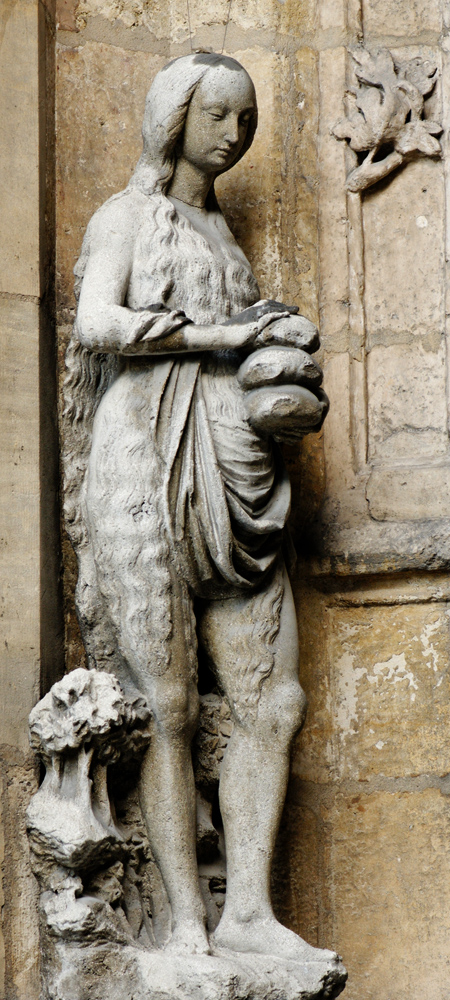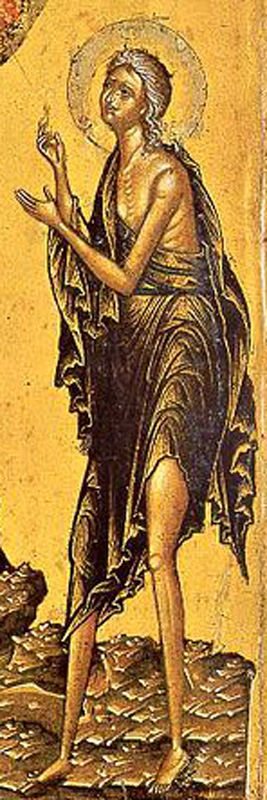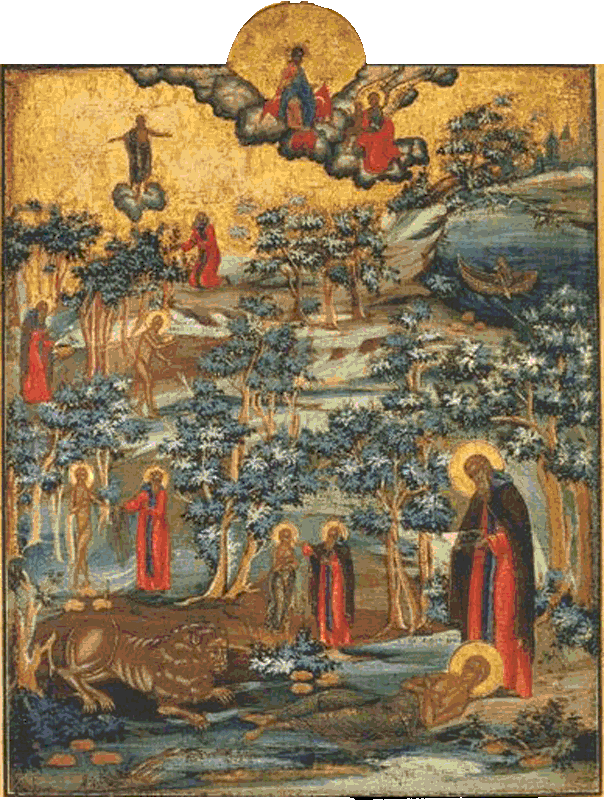Two years before her death she had been discovered by a monk named Zosimus. In Sophronius her hair was short and white with age, a detail that Voragine omitted, and her skin burned black by the sun. Zosimus gave her his cloak and returned the following year to bring her communion. When he came back the year after that, he found her dead and buried her with the help of a lion.
PORTRAITS
Mary's nakedness is an important part of the story, but exhibiting it in a sacred image was problematic. In the East, Zosimus' cloak usually hangs from one shoulder and covers her from the waist down, with her upper body either turned modestly to one side, as at right, or simply presented as if it were the chest of a man (example). The hair is short and white, as in Sophronius, and the body is gaunt. Images in the West follow a different strategy, giving the saint copious dark hair that falls over her body, covering it to mid-thigh, as in the first picture at right, or even to the ankles (example).Hans Memling's portrait of 1480 draws on the eastern tradition for the cloak draped from the shoulder and abandons the long-hair strategy, leaving the saint's upper body exposed to view. In Memling's and almost all other portraits she has a fair young face, despite the statement in the legends that Zosimus found her blackened by the sun.
The Memling panel also exemplifies an attribute often seen in portraits of this saint: three loaves of bread held in one hand. In the Legend she took these loaves with her into the desert and they lasted seventeen years.
She is also sometimes shown with a book (example). No books are mentioned in the Golden Legend account or in the much longer tale in the South English Legendary, but according to Sophronius she had a knowledge of scripture that came directly from God. The books in the images thus refer to this knowledge, even if actual books were not its source.
NARRATIVE IMAGES
The Russian icon at right covers the whole story from when Zosimus is told to go into the desert until he and the lion bury the saint and her soul is carried to Heaven. Among images that focus on single events, the last communion (example) and the burial (example) are the more likely to be presented.
Prepared in 2014 by Richard Stracke, Emeritus Professor of English, Augusta University. Revised 2016-09-14.
HOME PAGE

Statue at a Paris church with the hair and the three loaves (See the description page.)

Mary of Egypt in an Orthodox icon (See the description page.)

Icon tracing the story of Zosimus and Mary of Egypt (See the description page.)
ATTRIBUTES
- Three loaves
- Book
MORE IMAGES
- 9th century: A fresco of St. Mary wearing a proper garment and reading from a scroll.
DATES
- Feast day: April 2 in the West, April 1 in the East.
BIOGRAPHY
- Sophronius's Greek narrative was translated into Latin in the Vitae Patrum. See Migne, Pat. Lat., LXXIII, 671-690 and Acta Sanctorum, April vol. 1, 67-90. An English translation in in Stouck, 97-114, and several other translations have been posted online.
- Golden Legend #56: html or pdf
- South English Legendary, 262-271.
ALSO SEE
- St. Mary Magdalene is sometimes confused with this St. Mary.